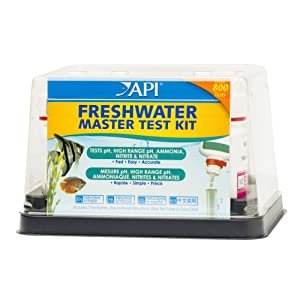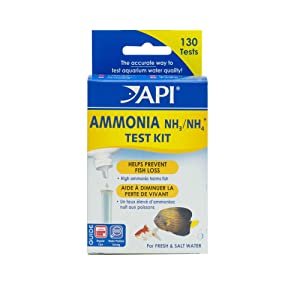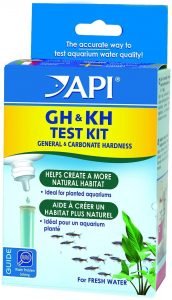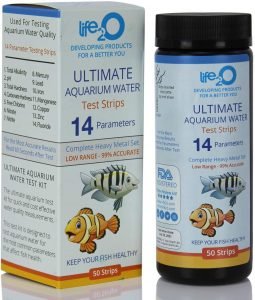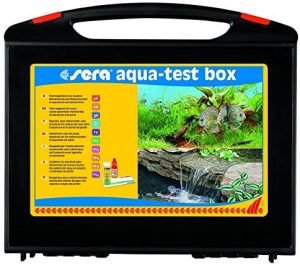Whether your aquarium is fresh water with a handful of fish or salt water with blooming coral …Â Keeping your water healthy and balanced is the only way your aquarium environment can thrive.
Although fresh and salt water tanks have different components to monitor. It is important to test the water weekly and if something appears to be wrong or if your fish start to behave strangely.
Comparison Table
| Custom | SiteStripe Image | Title | Review | Buy |
|---|---|---|---|---|
| TopBest Pick |  | API Freshwater Master Test Kit | 4..8/5.0 | Check Price |
| Top Performance |  | API Reef Master Test Kit | 4..5/5.0 | Check Price |
| cheapest |  | API Individual Aquarium Water Test Kit | 4.6/5.0 | Check Price |
To ensure that you create the best possible environment, it is important to find the best aquarium test kit for your aquarium needs. The best aquarium test kits are invaluable tools that every aquarist should have. This allows you to accurately measure the condition of your tank and adjust it if necessary.
Without this crucial information, you would not be able to know whether or not your tank is healthy. Meanwhile, your fish may be in pain! All of the most experienced aquarists we know invest in the best water testing kits they can get. If you’d like to follow suit, read this guide to see our recommendations.
What to test in the aquarium water?
Freshwater aquariums
The pH of the water is important in a freshwater tank, because too high or too low a pH can stress the fish. The pH scale ranges from acidic to alkaline and is measured from 0 to 14.
Most fish prefer something neutral that is between 6.6 and 7.8 in the center of the scale. You may need to make adjustments based on what your test results show and the type of fish you have. Some like a more acidic environment than others.
It is also important to know how much ammonia you have, as too much ammonia can kill fish. Ammonia comes from the breakdown of waste and uneaten food. For a healthy tank, the ammonia should always be zero.
It’s also important to check for nitrites and nitrates. Nitrites are the result of beneficial bacteria in the tank that break down ammonia. Nitrates are the result of the breakdown of nitrites. Nitrites are not as harmful as ammonia, but they can still cause a problem if they get too high.
Nitrates are the final stage of what is known as the nitrogen cycle. They are not really harmful and can be seen as a sign that bacteria in your tank are doing their job of breaking down ammonia and nitrites.
Hardness measures dissolved substances in water, in particular calcium and magnesium. Soft water can be a problem because the pH can drop if it is too soft. Alkalinity is an indicator of stability and how well water can maintain its pH. Too low and the pH fluctuates easily and can harm your fish and plants.
Seawater aquariums
For salt water tanks, check everything you would for fresh water, as well as salinity and chlorine.
Reef ranges
For reef tanks, check the same parameters as for salt water tanks, as well as phosphate, calcium and magnesium.
Calcium and magnesium are important for healthy coral growth and too much phosphate can lead to algae growth.
Planted aquariums
Test the same things you would for fresh water, as well as general water hardness (GH) and alkalinity (KH), which are essential for plant growth.
The Best Water Test Kits for Freshwater, Saltwater & Reef Tanks
You need to make sure you are using the correct type of sealant for the type of water your aquarium has. Salt water test kits do not work with fresh water and vice versa.
Aquarium Test Kit Reviews
1. API Freshwater Master Test Kit
To monitor the health of your freshwater aquarium, it is important to remember that many potential problems are invisible. The API Freshwater Master Test Kit should be used once a week and when problems arise.
This freshwater test kit comes with everything you need to test the most important elements in your freshwater aquarium: pH, high pH, ​​ammonia, nitrite and nitrate. These things greatly affect the life of your freshwater fish.
You get an instruction booklet, seven test solution vials, four test tubes, a test tube rack, a holder and color charts that are analyzed with the computer for accurate comparison and laminated so that they can tolerate getting wet during the test.
This kit is a great value as it can run over 800 full tests, meaning it will last a long time.
This kit is accurate enough to determine the basic levels and overall health of your aquarium. It can tell you what things are there that shouldn’t be and give you a rough measurement. This kit is usually sufficient to monitor and maintain a simple tank.
Check Price On Amazon2. API Reef Master Test Kit
Each type of aquarium requires different tests and the API Reef Master Test Kit gives you the tools you need to verify the safety of the water for your reef inhabitants.
You can perform more than 500 tests with this kit. It includes seven test reagent bottles, four glass test tubes, an instruction booklet and troubleshooting information for any problems you discover, and two laminated color charts so you can compare your result with accurate, computer-calibrated measurements.
This kit tests for calcium, carbonate hardness (KH), phosphate and nitrate, all important for the balance of your aquarium reef. Use it weekly to reveal invisible problems that your reef inhabitants may be facing or when problems arise.
This is a good kit if you are looking for something for general maintenance and you want to keep your water healthy and your plants and animals happy. It will give you a general reading of the levels of different elements in the water, but it won’t be able to give you really accurate readings.
Check Price On Amazon3. API Individual Aquarium Water Test Kit
These individual API test kits provide you with everything you need to test a specific level in your tank. Choose from kits for ammonia, copper, GH and KH, pH, nitrite and phosphate. This is not an all-in-one set – each set monitors a different water parameter.
While all-in-one kits have advantages, using a kit that proves one thing can be very helpful. For example, if you regularly run tests with an all-in-one kit and find that the pH is not right, a single test kit will only allow you to recheck the pH daily and get a more accurate reading.
Each kit includes two bottles of test solution, a glass test tube with snap-on cap and color charts to accurately interpret fresh and salt water tank results. It is easy to use and will give you results in seconds.
The phosphate kit is especially useful for planted tanks and if you have a problem with copper or can’t control the pH these kits are super accurate and you can focus on one parameter at a time.
Check Price On Amazon4. API Freshwater and Saltwater Aquarium Test Strips
These API strips are easy to use and give accurate results for five different parameters: water hardness, pH, nitrite, nitrate and pH.
Dip the strip in the aquarium water and rotate it twice. You can read the results directly by comparing the strip with the supplied table.
It also includes some troubleshooting instructions so you can find out what to do if something with the test doesn’t work. They even go into a little bit about which fish species prefer a different pH and other more specific information than a simple result.
These strips can be used for both fresh and salt water. They come in packs of four, 25 or 100 pieces. They recommend using the strips on a weekly basis, so sets of 25 or 100 strips are ideal.
If you’re setting up just one tank and want to monitor your cycling progress so you know when to safely add fish, the four-strip kit can help, but larger amounts are definitely a better value in the long run.
Check Price On Amazon5. VANSFUL Smart Water Test Kit
Vansful test strips test 10 different water parameters: pH, Alkalinity, Iron, Copper, Total Hardness, Lead, Fluoride, Free Chlorine, Nitrate and Nitrite. Immerse the strip in the water and wait 45 to 60 seconds for the results to be read.
This is a great option for a reef tank or a heavily planted tank, something you’d like to know more about than just the basics. If you have a fragile tank that requires a lot of care and maintenance, these strips will give you a lot of information.
The side of the bottle features an easy-to-read graph, each marked with the normal range, so you can immediately interpret the results. There are also 500 strips in the package, so you don’t have to worry about getting more strips for a while.
While this kit includes so many strips, the bottle is a good size and easy to transport, so it’s not difficult to take everything in good light to get the results accurately. If you have multiple tanks, it is also easy to switch from one to the other.
Check Price On Amazon6. Lifegard Aquatics 5 Way Test Strip
This simple test kit from Lifegard Aquatics checks five different parameters: nitrite, nitrate, hardness, pH and alkalinity. They are great for freshwater and saltwater aquariums, but can also be used to control pond water.
There are 25 strips in this kit and they test for alkalinity, water hardness, pH, nitrate and nitrite. The bottle is lined to keep moisture out and has an easy to open flip cap. With a graph on the side you can quickly read the results.
If you’re just setting up a tank and hoping it works, these test strips are a great choice. They are affordable and will tell you what you need to know to make sure your tank is running properly without having to take water samples to the pet store.
This is a good kit if you are looking for something a little simpler. Just test the necessary parameters and it is a good choice for a simple fresh water tank.
Check Price On Amazon7. API GH & KH Liquid Test Kit (Top Pick)
- General hardness (GH)
- Carbonate hardness (KH)
With the API GH & KH Liquid Test Kit you can check the carbonate and general hardness of your tank water.
These work a bit differently from other tests. You put the test solution into the water sample drop by drop, cover and turn the sample to mix it evenly.
Count the drops as you go until the sample turns a specific color. Each drop represents a degree of hardness (it works the same for general hardness or carbonate). So if it takes 3 drops to get the right color, the water has a hardness of 3 degrees.
These tests are very accurate and are the same tests that scientists use to test the hardness of water in the field.
One drawback is that it can be difficult to see the color change. If you are having trouble, look through the open top of the test tube instead of from the side.
It also bothers me that I have to buy these tests separately from the Master Test Kit I think the logic is that many aquarists don’t even pay attention to their GH and KH.
Check Price On Amazon8. Tetra EasyStrips
- Chlorine
- Total ammonia: ammonia (NH4 +) and ammonia (NH3)
- Nitrite
- Nitrate
- General hardness (GH)
- Carbonate hardness (KH)
- pH
Okay, I have to admit, I’m generally not a huge fan of most Tetra products, but I think their test strips are pretty good.
They are sold in small batches, which should help prevent spoilage.
I ran the numbers in these tests. They cost about $ 0.68 per test, compared to an average of $ 0.14 per test for liquid kits. That’s about 4.8 times the cost of liquid testing.
This is useful because you are running seven tests at a time. And I’ve found these are quite easy to read when you compare them to the chart.
Still, I recommend that you use common sense when using these (and any other brand of test strips). If something says 0 and it really doesn’t make sense, use a different strip and / or a liquid test kit so you can compare the results.
I also don’t like the fact that the bottle doesn’t tell you whether it’s testing total chlorine or just free chlorine.
There is a big difference.
Total chlorine indicates how much free chlorine (regular chlorine) and combined chlorine (chloramine) is in the water. A test that registers only free chlorine will not detect chloramine in the water.
So you might think that tap water is safe without dechlorination when it actually contains a deadly substance that can kill your fish.
Since the manufacturer doesn’t specify what kind of test it is, they don’t know if chloramine will show up.
Play it safe, add dechlorinator.
Check Price On Amazon9. Life2O Ultimate Aquarium Water Test Strips
- Free chlorine
- Nitrite
- Nitrate
- General hardness (GH)
- Carbonate hardness (KH)
- pH
- Total alkalinity
- Mercury
- Send
- Iron
- Manganese
- Buyer
- Zinc
- Fluoride
I like that this allows you to test for heavy metals, something that can sometimes contaminate municipal drinking supplies. Fish can be even more sensitive to this than humans, so it is better to know if they are present in tap water.
Using a reverse osmosis (RO) unit to purify some of your replacement water would also be a great way to check how efficiently your membrane is working.
Reverse osmosis membranes wear down over time. So if you used a strip in your RO water periodically, the tests that started showing a positive result would let you know if you need to replace the membrane in your unit.
At $ 0.30 per test, these are quite inexpensive compared to other test strips.
A disadvantage is that these strips show free chlorine, but not total chlorine. This means that they will only show results if your water supply uses pure chlorine.
But nowadays more and more water companies have switched to chloramine, which is chlorine that is bound to ammonia. Chloramine does not appear in a free chlorine test. This could lead some aquarists to believe that their water is safe for fish when it actually contains a deadly substance.
My other complaint is that these strips test for 14 different substances, but ammonia is not one of them! Since ammonia can be an assassin in your tank, it is best to skip something like fluoride (non-toxic to fish) and replace it with ammonia (very toxic to fish).
Check Price On Amazon10. Sera Aqua-Test Box (+Cl)
- High range PH
- Low range PH
- General hardness (GH)
- Carbonate hardness (KH)
- Total ammonia: ammonia (NH4 +) and ammonia (NH3)
- Nitrite
- Nitrate
- Phosphate
- Iron
- Chlorine
The Sera Aqua-Test Box (+ Cl) is an excellent complete test kit that includes basic water parameters plus a few extras, such as phosphate and iron, which are great for planted tanks.
You can store everything neatly in the carrying case, so you don’t constantly lose parts or have to keep each individual test in a cardboard box.
Test tubes are much larger than many of the standard liquid tests, which makes them easier to use as you don’t have to constantly worry about them falling out.
I was very impressed with the color comparison chart as it is much larger than most tests, making it easier to read.
Instructions can be difficult, especially for beginners, as English instructions alternate with German and other languages. Some users complain that the printout is small and tight, it’s not something you can scan quickly and get what you need for testing.
It also only tests for total ammonia, there is no separate test that allows you to compare total ammonia (ammonia and ammonia) with free ammonia (ammonia only).
And it doesn’t specify whether it tests for total chlorine or just free chlorine. This is an important distinction, as total chlorine will show you chlorine and chloramine on a regular basis, and free chlorine testing will only register regular chlorine.
Check Price On AmazonWhat is the best marine aquarium test kit?
Marine Best Aquarium Test Kits need to be particularly accurate because corals, plants and animals are even more sensitive in these types of environments.
The Salifert Master Reef Combo Test Kit is easy to use and comes with everything you need to test for calcium, nitrate, phosphate, pH, alkalinity and magnesium.
What is the best freshwater aquarium test kit?
If you are looking for the best freshwater aquarium test kit, look no further than the API Freshwater Master Test Kit. It comes with everything you need to ensure that the pH, high pH, ​​ammonia, nitrate and nitrite levels are ideal for your tank to thrive.
This kit is amazingly valuable as it contains enough materials to run over 800 full tests. You will receive an instruction booklet, all the testing solutions and the supplies you need.
Plus computer-analyzed laminated maps so you can compare your result with an accurate scale that tells you which things are in safe range and which ones need to be corrected.
What is the best marine aquarium test kit?
The best marine aquarium test kit has to be the API Saltwater Master Test Kit, this kit contains everything you need to keep your marine fish and invertebrates happy.
This is an extremely accurate kit that tests high pH, ​​ammonia, nitrate and nitrite, the things most important to maintain balance in a salt water tank.
Not only does this kit contain everything you need, it also has enough testing supplies to test 550 times! You don’t need to top up this kit for long as it comes with many supplies. Good evidence and great value – how can you go wrong?
How do you use an aquarium test kit?
While there are differences from kit to kit and between different brands, all Best Aquarium Test Kits are used on the same base.
First, collect your materials: test solutions, color chart to compare results, test tubes, syringes, or other methods of obtaining a water sample from your aquarium. Everything you need is normally included in the kit.
Next, it is a good idea to label each tube with what is being tested. For example, write “pH” on one tube and “nitrate” on the other to avoid confusion. Repeat for every part and pipe. If you don’t want to write on the tube, label the holder to see what you put in each tube. This is the only way to make sure you read the results accurately.
Once everything is labeled, fill each test tube with the amount of water recommended in your kit instructions. 5 ml is a common amount, but your kit may vary. Add one of the solutions to each test tube. The number of drops will also vary, so read the specific instructions for your kit. Depending on what you are testing, the drops can vary between three and ten drops.
Prepare one test tube at a time. Add the correct number of drops, replace the cap and shake the tube to mix. Then move on to the next tube, add the correct number of drops, replace the cap and shake. Do this until the pipe tests another part.
Each solution will develop and the water will change color depending on the amount of what is being tested in the water. Compare the result with the table provided with your kit. If everything is within an acceptable range, that’s fine until next week. If anything needs to be adjusted, take appropriate action and retest later in the day.
As mentioned above, the kit you choose may vary slightly so read the instructions carefully. This is a simple explanation, but there are some kits that are a bit more complicated than the ones described here.
Video guide about How To Test Your Aquarium Water
Conclusion
If you have invested a lot of time and money in building the perfect aquarium, it is important that you do everything you can to make it bloom. This includes ensuring that the water is perfectly balanced, so that your fish, plants and other living things live in harmony and keep your aquarium beautiful.
The only way you can check how healthy the water is in your tank is to use an Best Aquarium Test Kits. Keep in mind that salt and freshwater aquariums use different Best Aquarium Test Kits, so make sure you use the right one.
To decide which is the best, it only makes sense to use the best water aquarium test kit. This will ensure you get the most accurate results so you can tune the water to make it the perfect home for your fish, coral and plants.

![Top 10 [2023] Best Aquarium Test Kits Help Monitor Water Quality Top 10 [2023] Best Aquarium Test Kits Help Monitor Water Quality](https://aquariumhunter.com/wp-content/uploads/2021/02/maxresdefault-2.jpg)
